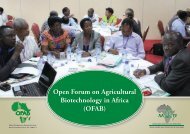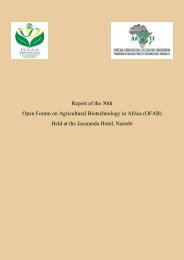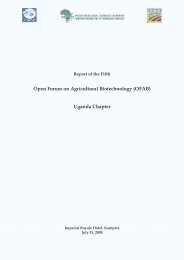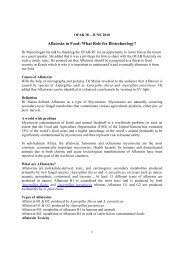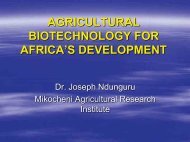Annex 1 List of Participants - OFAB
Annex 1 List of Participants - OFAB
Annex 1 List of Participants - OFAB
Create successful ePaper yourself
Turn your PDF publications into a flip-book with our unique Google optimized e-Paper software.
Summary <strong>of</strong> presentation<br />
Genetic transformation <strong>of</strong> cowpea for insect resistant germplasm: Opportunities<br />
and Challenges<br />
By Dr. T.J Higgins, lead researcher in the Cowpea transformation project in Africa.<br />
Dr. T.J Higgins, the lead researcher in the Cowpea transformation<br />
project in Africa, started his presentation by informing the<br />
participants now happy he was back in Kenya as he had been in<br />
the country before as a tourist.<br />
He thanked AATF for giving him the opportunity to share with<br />
various stakeholders, the findings <strong>of</strong> the cow pea transformation<br />
project in Africa.<br />
Dr. T.J Higgins gave an insight on modern biotechnology explaining aspects <strong>of</strong><br />
cloning, gene technology (genetic modification, GM), molecular markers and<br />
cloning <strong>of</strong> GM animals. He emphasized the importance <strong>of</strong> the gene technology since<br />
it laid the foundation for the success <strong>of</strong> Bt cotton in Australia.<br />
He gave highlights on biotechnology traits in Australian cotton in the short to<br />
medium term and gave details <strong>of</strong> the source <strong>of</strong> the gene, chronology <strong>of</strong> additional<br />
insects and herbicides from 1996.<br />
He said that “in the next 10 years many crops will come up due to conventional<br />
breeding programs in many research institutions. A farmer would make USD 350<br />
per hectare which may not appear highly pr<strong>of</strong>itable but he would have cut on pest<br />
management practices.”<br />
Dr. Higgins gave an overview <strong>of</strong> regulatory control <strong>of</strong> GM crops in Australia. He<br />
said that during research and development, environmental and human safety checks<br />
are put in place through Institutional Biosafety Committee, Office <strong>of</strong> the Gene<br />
Technology Regulator and other relevant bodies before commercial release.<br />
He said that in Australia, the release <strong>of</strong> GM crops is faced with public awareness and<br />
acceptance issues. Regular subjects <strong>of</strong> controversy include; information about the<br />
technology, human safety, environmental safety, sustainability, informative labeling,<br />
control <strong>of</strong> food chain by multi-nationals and market access.<br />
He said the economic impact <strong>of</strong> GM crops from 1996-2004 was USD 27 billion. In<br />
2005, it was USD 5.25 and in 2006 it was estimated at 5.5. He reiterated that the<br />
environmental impact <strong>of</strong> GM crops between 1996 and 2004 showed a reduction <strong>of</strong><br />
172,500 tones <strong>of</strong> active pesticide ingredients that translates to a 14% reduction in<br />
environmental impact.<br />
7



